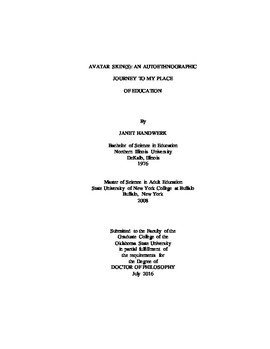| dc.contributor.advisor | Bailey, Lucy E. | |
| dc.contributor.author | Handwerk, Janet | |
| dc.date.accessioned | 2017-02-22T22:09:28Z | |
| dc.date.available | 2017-02-22T22:09:28Z | |
| dc.date.issued | 2016-07 | |
| dc.identifier.uri | https://hdl.handle.net/11244/48811 | |
| dc.description.abstract | This autoethnography presents the avatar as a liberating learning platform for those who live on the edges of hegemonic and heteronormative society. I call this platform "avatar as place of education." I illustrate how my avatar was a place for processing self-learning (learning about myself) by recounting and exploring my queer identity development through my experiences as student, educator, and gamer traveling between virtual and physical worlds. I write to inquire and to seek to achieve an understanding of my avatar place and my emotional response to marginalization as a lesbian. To craft this autoethnography, I draw data from physical world memories, journals, photographs, and from in-world experiences in Second Life (SL). I situate this project in educational technology and draw from women's and gender studies, and from studies about place, virtual gaming characters, "avatars," and avatar customization to inform my analysis. | |
| dc.description.abstract | I conceptualize avatar as place of education because they: first, exercise agency for their physical world counterparts and vice/versa; second, may become deliberate through changing avatars, third, have educative meaning and value for all individuals but may serve as an especially crucial aspect of education for marginalized youth; fourth, relate reciprocally and teach the user through feedback and transfer. Lastly, users' intentional creations of avatar places have potential value as an avenue to experience virtual world choices about social norms, identity, and community. Avatar places offer self-education, self-creation and self-knowledge possibilities for many people exploring aspects of their identity, especially for those marginalized in society. | |
| dc.description.abstract | This study contributes to research regarding player needs, avatar customizations, and game design, and reinforces research that details the heteronormative affordances of North American game design which exclude culturally and sexually marginalized students from personal identity options in avatar interfaces (Consalvo, 2012; Ducheneaut, Wen & Yee, 2009; Nakamura, 2002, 2013; Pulos, 2013; Schmieder, 2009; Taylor, 2003). Virtual world participation helps negotiate heteronormative practices. My work also extends discourse about queer-friendly opportunities and practices in schools. This work is productive in arguing for commercial virtual worlds in formal education to meet the needs of 21st century technology skills. | |
| dc.format | application/pdf | |
| dc.language | en_US | |
| dc.rights | Copyright is held by the author who has granted the Oklahoma State University Library the non-exclusive right to share this material in its institutional repository. Contact Digital Library Services at lib-dls@okstate.edu or 405-744-9161 for the permission policy on the use, reproduction or distribution of this material. | |
| dc.title | Avatar skin(s): An autoethnographic journey to my place of education | |
| dc.contributor.committeeMember | Lamphere-Jordan, Patricia M. | |
| dc.contributor.committeeMember | Antonenko, Pasha | |
| dc.contributor.committeeMember | Hammer, Tonya R. | |
| osu.filename | Handwerk_okstate_0664D_14828.pdf | |
| osu.accesstype | Open Access | |
| dc.type.genre | Dissertation | |
| dc.type.material | Text | |
| thesis.degree.discipline | Professional Education Studies | |
| thesis.degree.grantor | Oklahoma State University | |
